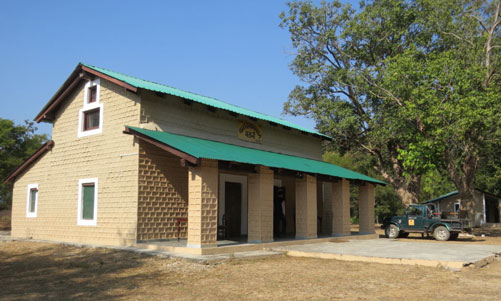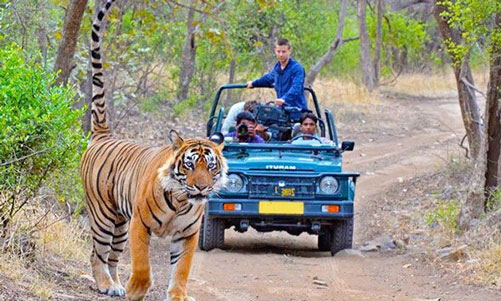The Website of Jim Corbett National Park provides detailed information on wildlife tourism, including safari bookings and accommodations. Visitors can book various safari options such as Jeep safaris, Canter safaris, and elephant rides in different zones of the park, such as Dhikala, Garjiya, Dhela, Phanto, Bijrani, Durgadevi, Sitabani, and Jhirna. The website also allows users to book night stays at forest lodges like Dhikala, Jhirna, and Bijrani. These bookings can be made up to 45 days in advance, and all permits, including guide and driver fees, must be paid for separately.
For bookings, you can visit the official site Jim Corbett National Park or Corbett Tiger Reserve portal, where you can check permit availability and make reservations online corbettgov.org.
Corbett Tiger Reserve
Corbett Tiger Reserve is one of India's premier wildlife sanctuaries and plays a pivotal role in the conservation of the Bengal tiger. Located in the Nainital district of Uttarakhand, the reserve encompasses a diverse range of habitats, making it a hotspot for biodiversity. Here is a comprehensive overview of Corbett Tiger Reserve:
Overview
Establishment: The reserve was established in 1973 under the Project Tiger initiative, India's flagship tiger conservation program. It is named after Jim Corbett, a renowned British-Indian hunter-turned-conservationist who was instrumental in the establishment of the original Hailey National Park, now known as Jim Corbett National Park.
Geographical Spread: Corbett Tiger Reserve covers an area of approximately 1,318 square kilometers, making it the oldest national park in India. It includes the core area of Jim Corbett National Park along with additional buffer zones and other adjoining protected areas.
Zones Within the Reserve
Jim Corbett National Park: The core area, spanning about 520 square kilometers, is divided into four main zones:
Dhikala Zone: The largest and most popular zone, covering around 344 square kilometers. It offers some of the best wildlife viewing opportunities and is home to the famous Dhikala Lake.
Bijrani Zone: Encompassing approximately 70 square kilometers, this area is known for its picturesque landscapes and diverse wildlife.
Jhirna Zone: Covering about 68 square kilometers, it is characterized by dense forests and rich biodiversity.
Dhela Zone: A smaller area that complements the other zones in terms of habitat diversity.
Buffer Zones: Surrounding the core areas, these zones help in minimizing human-wildlife conflicts and provide additional habitat for wildlife. They include regions like Kanali, Uttari Dhikala, and Champawat.
Adjacent Protected Areas: Corbett Tiger Reserve is contiguous with other protected regions such as the Pauri Garhwal Wildlife Sanctuary and the Nainital Wildlife Sanctuary, enhancing its ecological significance.
Biodiversity
Corbett Tiger Reserve boasts a rich and varied ecosystem, supporting a wide array of flora and fauna:
Mammals: Besides the iconic Bengal tiger, the reserve is home to leopards, elephants, sloth bears, spotted deer, sambar, barking deer, and wild boars.
Birds: With over 600 species recorded, it is a paradise for birdwatchers. Notable species include the Himalayan griffon, crested serpent eagle, and various hornbills.
Reptiles and Amphibians: The reserve hosts numerous species, including king cobras, pythons, and various frogs.
Flora: The vegetation ranges from dense sal and oak forests to grasslands and riverine ecosystems. This diversity supports the wide range of wildlife found here.
Conservation Efforts
Tiger Conservation: As part of Project Tiger, the reserve employs strategies like anti-poaching measures, habitat restoration, and community engagement to protect and increase the tiger population.
Human-Wildlife Conflict Mitigation: Initiatives are in place to reduce conflicts between local communities and wildlife, including awareness programs and compensation schemes for livestock loss.
Research and Monitoring: Continuous scientific research and monitoring help in understanding the ecosystem dynamics and the effectiveness of conservation strategies.
Tourism and Activities
Corbett Tiger Reserve is a major tourist destination, attracting nature enthusiasts, wildlife photographers, and adventure seekers. Key activities include:
Safaris: Available in various zones, safaris can be conducted using jeeps, canters, or on elephant back. The Dhikala Zone is particularly popular for jeep safaris.
Bird Watching: The reserve's rich avian population makes it ideal for birdwatching tours.
Trekking and Nature Walks: Several trails offer opportunities to explore the park's natural beauty on foot.
River Rafting: The Ramganga River provides options for rafting, adding an adventurous aspect to the visit.
Best Time to Visit
Peak Season: November to June is ideal, with the best wildlife sightings typically occurring between September and June.
Winter (November to February): Pleasant weather and clear skies enhance wildlife viewing and photography.
Summer (March to June): Although warmer, this period offers lush greenery and active wildlife.
Accommodation
The reserve offers a range of accommodation options, from luxury resorts to budget-friendly lodges. Some popular choices include:
Jim Corbett National Park Lodges: Located in various zones, providing comfortable stays with easy access to safari points.
Corbett Tiger Reserve Resorts: Offering amenities like guided tours, nature walks, and recreational activities.
Accessibility
By Air: The nearest airport is Pantnagar Airport, approximately 80 kilometers away. Other nearby airports include Delhi and Dehradun.
By Rail: Ramnagar Railway Station is the closest railhead, situated about 15 kilometers from the reserve.
By Road: Well-connected by road, with regular bus and taxi services from major cities like Delhi, Nainital, and Haldwani.
Significance
Corbett Tiger Reserve is not only crucial for tiger conservation but also serves as a model for sustainable tourism and community involvement in wildlife protection. Its rich biodiversity and scenic landscapes make it a valuable ecological and tourist asset for India.
Tips for Visitors
Permits: Ensure to obtain the necessary permits for safari bookings in advance, especially during peak seasons.
Guided Tours: Opt for guided safaris with experienced naturalists to enhance wildlife spotting chances and gain deeper insights into the ecosystem.
Respect Wildlife: Maintain a safe distance from animals, avoid making loud noises, and follow park rules to minimize disturbances to wildlife.
Pack Accordingly: Carry essentials like binoculars, cameras, comfortable clothing, insect repellent, and sufficient water.
Corbett Tiger Reserve stands as a testament to successful wildlife conservation and offers an enriching experience for those looking to immerse themselves in nature's splendor.



























Thx so so much Mr. Shikhar Chauhan for such wonderful hospitality and services!
Rajesh Dham